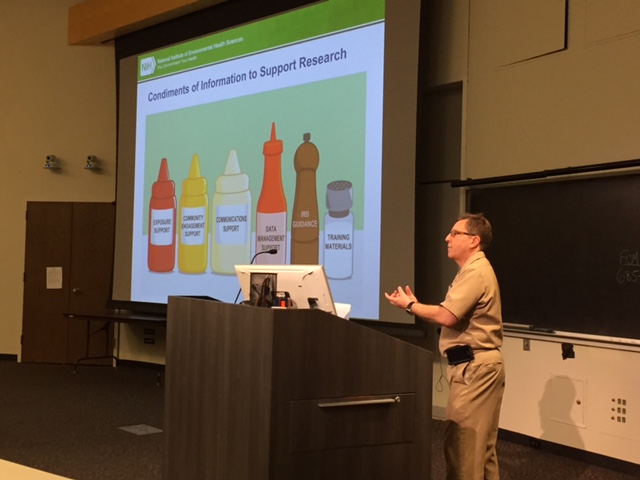Dr. Aubrey Miller from NIEHS presents the
DEOHS Environmental Health Seminar
(photo: Liz Guzy)
The EDGE Center was privileged to host Dr. Aubrey Miller of the National Institute of Environmental Health Sciences (NIEHS) to present the DEOHS Environmental Health Seminar on May 25th. Dr. Miller is Senior Medical Advisor to NIEHS Director Dr. Linda Birnbaum. He leads the NIH Disaster Research Response (DR2) Program and has been extensively involved in the NIH Gulf Oil Spill response, among other national disasters.
When a disaster occurs, the immediate focus is to save lives and protect health. But after these immediate needs are met, questions arise about health effects on communities and rescue workers. There is an opportunity to learn from the disaster and be able to respond better the next time. A great deal of public health work is built on what has been learned from disasters.
But responding to a disaster is all-consuming. The response is not set up to do research. So a goal of DR2 is to fill this gap by figuring out how to do well-designed and effectively executed research in and after an emergency. The program aims to assemble tools in a ready-to-go toolkit. Epidemiological tools, bio-specimen kits, and environmental sampling tools are being developed to quickly initiate studies after a disaster.
EDGE Director Terry Kavanagh
and NIEHS's Aubrey Miller
(photo: Marilyn Hair)
Dr. Miller said that one of the challenges in a disaster is coordination. No single agency or community has all the tools and information needed to respond to a disaster. A multitude of public and private agencies must coordinate efforts.
Also, community involvement is essential. Listening to and addressing community concerns and questions builds cooperation and trust, increases the chance that the right questions are being asked, and offers an opportunity to collect on-the-ground information. DR2 emphasizes community engagement, helping to apply scientific research to help communities. It's a chance to protect communities.
While on campus Dr. Miller also met with researchers from the University of Washington Post-Disaster Rapid Response Research Facility (RAPID), a disaster investigation center that provides instrumentation and tools to collect and assess critical post-disaster data with the goal of reducing physical damage and socio-economic losses from future disasters. More about the new RAPID facility at UW can be found here and here. The goal of the meeting between the EDGE and RAPID Centers was to brainstorm ways for future collaboration, leveraging the unique resources of each Center.

Dr. Miller and Outreach Manager
Marilyn Hair discuss DR2
(photo: Christine Tran)
The EDGE Center hosted an afternoon reception in Dr. Miller's honor, giving about 30 Department of Environmental and Occupational Health Sciences (DEOHS) researchers, staff and students, and RAPID, Seattle & King County Public Health, Northwest Healthcare Response Network, and the City of Seattle Office of Emergency Management partners the opportunity to meet him and discuss disaster research response.
--Marilyn Hair



